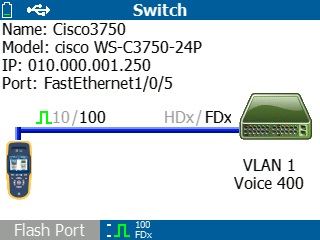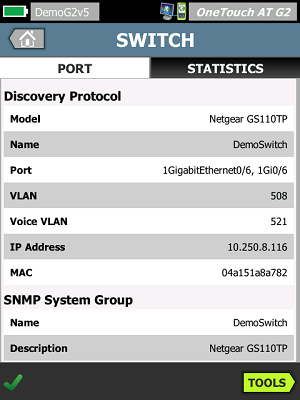



Our NetAlly products examine the first Layer 2 discovery packet to determine nearest switch. Information is displayed based on its availability via:
This is used to identify the nearest switch, the connected port, the switch’s address, and other information when available. Subsequent Layer 2 packets are not parsed by any unit. In the examples below, you will notice the switch name, model, IP, port, and VLAN information.


|
Result
|
Meaning
|
|---|---|
| 1/0/38 | The 1 refers to the switch. It will almost always be a 1 because most environments don't have fail-over switches working in tandem. |
| 1/0/38 | The 0 refers to the module. If there are blades in the switch, then the number appearing here will report which blade the port is located in. |
| 1/0/38 | The 38 refers to the port number. |
Missing Info:
If you are missing some or all of the information above you'll want to check a few things:
1. Keep in mind that these units are capable of listening to these packets from more than one source and it will display the first one it receives (this may not always be from its link partner.)
2. Does the switch support port advertisement? If so, how is it configured to advertise - on link or interval?
3. Is there congestion on the network? This can cause a delay in transmission and it might not be received in time or after another advertisement.
4. A packet capture can help identify the timing and information transmitted. To obtain a packet capture review the article How to Obtain a Packet Capture.
CDP and LLDP Info:
CDP Cisco Discovery Protocol
CDP is Cisco’s propriety protocol that runs between directly connected Cisco devices such as (Routers, Switches, IP Telephony, etc.). The purpose of the protocol is to supply a network device with information about its direct connected neighbors. Cisco devices send CDP announcements to the multicast destination address 01-00-0c-cc-cc-cc, out each connected network interface.
LLDP - Link Layer Discovery Protocol
LLDP specifically defines a standard method for Ethernet network devices such as switches, routers and wireless LAN access points to advertise information about themselves to other nodes on the network and store the information they discover.
LLDP frames are sent at fixed intervals on each port that runs LLDP. LLDP protocol data units (LLDP PDUs) are sent inside Ethernet frames and identified by their destination Media Access Control (MAC) address (01:80:C2:00:00:0E) and Ether type (0x88CC).
Mandatory information supplied by LLDP is:
Chassis ID
Port ID
TTL - Time to live value